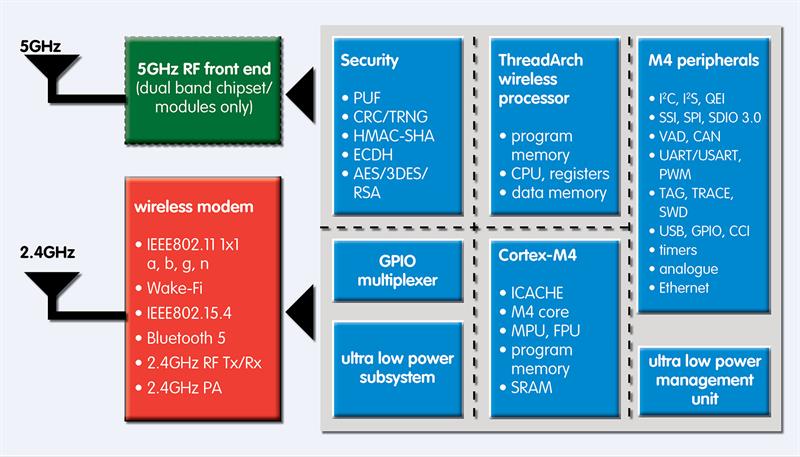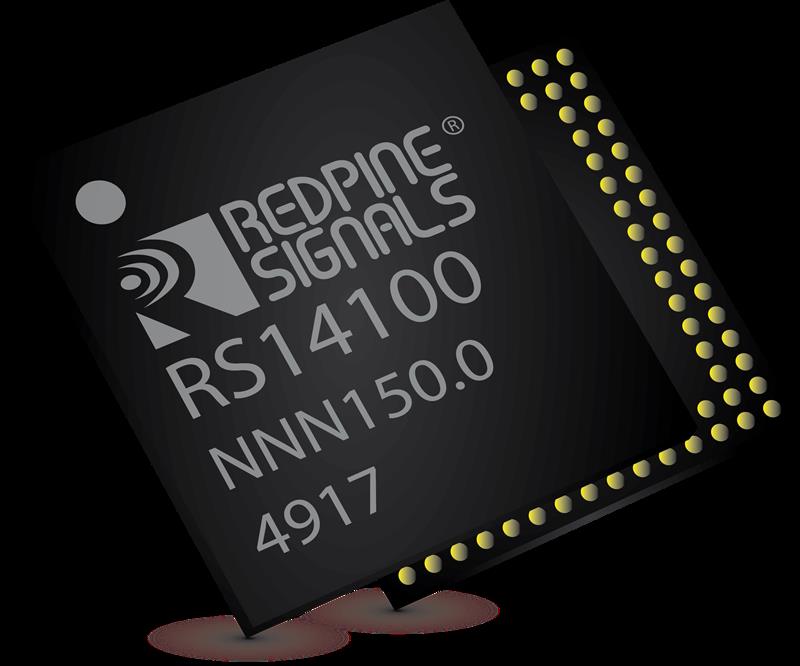As the Internet of Things becomes more of a reality, products for a wide range of applications are appearing that offer the required connectivity. Many of these have been developed for the consumer market or for IoT edge applications.
For both sectors, cost and performance are driving factors, which means component count and product size also play a major role. So it’s no surprise to find that engineers are looking for low cost, high performance MCUs which offer a selection of connectivity options. Step forward the wireless MCU.
While the concept of a wireless MCU isn’t new – New Electronics has been reporting on them for close to a decade – recent developments have seen the devices offer a new level of performance.
Established in 2001 as a WiFi specialist, Redpine Signals was one of the first to unveil an 802.11n chipset. In 2013, it launched what it said was the first multiprotocol wireless chipset for IoT applications. But at the end of 2017, it introduced two concepts aimed at the embedded market –WiSeConnect and WiSeMCU, which features a range of connectivity options and an integrated MCU.
Dhiraj Sogani, vp of marketing, contends the market for its wireless MCU modules is huge. “All devices need connectivity,” he asserted, “and wireless is important, not only for local links, but also to connect to the cloud.”
But this huge market to which Sogani pointed is also difficult to address. Jack Ogawa, Cypress’ senior marketing director for MCUs, said: “The market is extremely fragmented; we have to cover a spectrum of applications – and that spectrum is broad. It also means the ‘state of the art’ hasn’t been set, so technology continues to develop rapidly.” The consequence, Ogawa observed, is the balance between having a good processor and wireless performance is moving dynamically. “And it all depends on the application,” he added.

| Block diagram of Redpine's RS14100 wireless MCU |
Redpine’s WiSeMCU – also called the RS14100 – is said by the company to be the lowest power multiprotocol wireless MCU currently available. Designed around the ARM Cortex-M4F, the part can run at up to 180MHz and features a choice of dual-band 802.11abgn Wi-Fi, Bluetooth 5 and 802.15.4; the latter being suited for Thread or ZigBee.
Sogani said: “We’ve put a lot of effort into developing the system architecture; it’s not just about taking advantage of the power savings from the latest process node. While these devices are fabbed on a 40nm line, we’ve had to develop new techniques that reduce power consumption even further.”
While the RS14100 is said to draw 12µA/MHz in its lowest power mode, standby consumption has been a design target. “Most IoT devices are sleeping most of the time,” Sogani pointed out. “They wake up to transfer data, then go back to sleep. Battery powered devices depend on stand by current if they are to have a long operating life. We’ve reduced this to less than 500nA in deep sleep and believe this is three to four times lower than the competition.” Meanwhile, data throughput is said to be greater than 90Mbit/s, with the Cortex-M4F core acting as a ‘gear shifter’, responding dynamically to data processing requirements.
Ogawa noted: “When my device is asleep, it should consume little current. But there’s also work efficiency; when the device is awake, how quickly can it perform tasks and then go back to sleep? A balance between good sleep consumption and work efficiency is important – and that’s what we’ve targeted with PSoC6. Low power, more processing and an embedded secure element are vital for IoT apps.”

Interestingly, Redpine has also integrated a four threaded processor that handles networking and security tasks, along with a physically unclonable function.
Asked what customers are demanding, Brian Bedrosian, vp of marketing with Cypress’ IoT business unit, said: “In general, three things. Ultra low power, but high performance parts with Bluetooth LE (BLE) for mesh, beacon and sensor applications.
| The RS14100 is said to have the lowest deep sleep consumption of all wireless MCUs |
They also ask for ‘better’ devices, with more processing power and a flash/RAM footprint to support more complex applications. In this category, we’re seeing requests for parts with BLE only, BLE and Bluetooth, and BLE plus WiFi. One way we can meet these requests is with a PSoC6 and a discrete wireless chip. Finally, there are those who want the ‘very best’; a high performance MCU running at more than 300MHz, large RAM provision, wireless such as 802.11ac and an analogue controller.”
Ogawa added: “Everything in the embedded sector boils down to performance and cost and this ‘good/better/best’ approach is good way to cover the market.”
Edge processing has brought with it a need for more computing muscle. “While there is still computation in the cloud,” Sogani pointed out, “there is a lot more edge processing, which has power consumption implications.” Ogawa noted: “We’re looking at power efficiency, rather than µA/MHz, and performance on demand. I believe voltage and frequency scaling will be important.
“However, some wireless MCUs will need have to have good front end – and that’s not a cloud function. Designers realise they can do that with an M4. But, as devices get smarter, there will always be the need for more processing capability.”
A modular approach may work in some applications, but wearables don’t always have that luxury. Cypress’ PSoC6 has been selected for use in the Oura Ring, processing data from biometric sensors and providing BLE connectivity.
Petteri Lahtela, Oura Health’s CEO,. “The new Oura ring required long lasting battery life, increased processing capacity and the use of advanced sensors, all in a stylish and comfortable form factor. Cypress helped us to meet these requirements and redefine what is possible for wearable health products.”
“Integration is king,” Ogawa concluded. “If you can bring it all together, that’s attractive.”
| Wireless MCU comes as a system in package A wireless MCU solution introduced in 2017 by Microchip takes the form of a system in package (SiP) in which a SAM L21 MCU is integrated alongside an IEEE802.15.4 sub GHz radio. The SAM R30, said to deliver design flexibility and proven reliability, is targeted at connected home, smart city and industrial applications. The SAM L21 MCU features a Cortex M0+ core running at up to 48MHz. Within the SiP, there is 256kbyte of flash and 40kbyte of SRAM, 8kbyte of which is battery backed. Power management technologies and ultra-low power peripherals are said to allow the SAM R30 to typically draw less than 500nA at 1.8V in sleep mode. Configurable peripherals include up to five I2C/SPI /UART interfaces, with one in the low power domain, eight 12bit A/D converter channels and 48 capacitive touch channels with proximity sensing. Meanwhile, the radio operates at frequencies ranging from 769 to 935MHz range, allowing the R30 to cover applications in China (780MHz), Europe (868 MHz) and North America (915MHz). According to Microchip, the radio supports BPSK and O-QPSK modulation, with a transmit power of up to 11dBm and a receive sensitivity of -110dBm. This power level allows nodes featuring the SiP to be up to 1km apart, with the range doubled in a star topology. |













